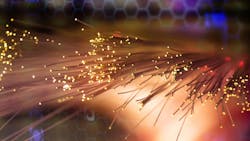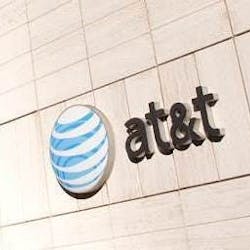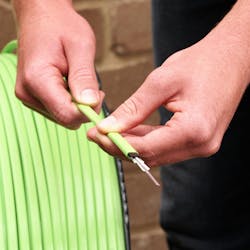During a Fiber Broadband Association webinar on March 28, John George, senior director of engineering at OFS and a member of the FBA’s technology committee, discussed a recently published FBA whitepaper that explores the longevity and scalability of fiber.
“We authored the paper with a lot of input from our technology committee members and research we did,” he said. “In summary, we found—kind of contrary to what we’ve heard some saying in other forums—that fiber has no known expiration date.”
George reported that the whitepaper’s findings show that fiber not only has the ability to support the data needs of today but will be able to support exponentially increasing amounts of data for the foreseeable future.
“We at FBA believe that fiber broadband investments should be scalable and durable,” he said, “particularly for public investments that are expected to provide long-term value to a community—and we have so much public funding of broadband infrastructure upcoming: with BEAD and other sources, $70-$80 billion is being invested in broadband in the coming four to five years. We found that future decades are going to continue to bring greater demands for applications that we can’t even envision today, and investments made today really need to keep pace with decades of growing demand. Fiber is a scalable durable infrastructure, with no upgrades required to the outdoor infrastructure and no known expiration date.”
Driving the data demand
George reported that the demands of today’s and future applications are driving both high speeds and lower latency. Real-time applications like virtual reality (VR) and augmented reality (AR) that render imagery and work with the cloud require very high capacity and low latency. VR and AR applications in all-day wearable devices are especially demanding.
“The video of your actual physical surroundings is being uploaded constantly to the cloud,” said George, “and then, in the cloud, there may be some processing or augmentation of that, and that is all being downloaded right in front of your visual field in real-time. And you can imagine, if this doesn’t happen instantly—if there’s any discordance between the imagery that we’re seeing in real-time in front of us as well as what’s being rendered from the cloud—this can create motion sickness and a lot of issues, researchers have found. So, to have richer visual content to make this a very immersive experience, we will need up to 5 Gbps just for one wearable device. Processed on the cloud, it’s going to require a very high capacity and low latency broadband network. And particularly for AR, the upstream bandwidth may be even higher than the downstream bandwidth requirements. And this is why we see network demands trending towards symmetrical gigabyte and faster with very low latency and very quick reaction time required.”
The FBA technology committee forecasts that the demands of augmented virtual reality coupled with AI enhancements will steadily increase as the decade goes on.
“We could see a need for 2 Gbps symmetrical peak bandwidth demand to a household of four,” he said. “And then, if we make assumptions based on various growth rates—we’ve been growing in the 25% per-year range—if we grew 15% per year after 2030, by 2040, we would need something in the order of 8 Gbps symmetrical; with a 30% growth rate, we’d be approaching 30 Gbps symmetrical. Now, these seem like very high numbers, but I recall a few years back, people thought a gigabyte was ridiculous, and now we have a gigabyte available and used by a very high percentage—I think over 30% of homes in the U.S. have gigabyte available.”
George further reported that the theoretical capacity for a single optical fiber is about 600 Tbps, or 600,000 Gbps, and that 300 Tbps speeds have been recently demonstrated.
“This 600 Tbps capacity will be accessible eventually over time,” he said, “and this is the known capacity and might increase as we learn more about the transmission characteristics of optical fiber.”
Fiber Scalability
Andreas Flack, who leads fixed network business development for Nokia, discussed the scalability of fiber during the broadcast, predicting that fiber deployments will only continue to increase.
“One of the things that really is obvious when you look at the past couple of years and the outlook going forward: fiber deployments are growing,” he said. “XGS-PON is proceeding with dominance in the market, and it is starting to freeze out slower technologies like GPON. We have a wide field of standards available that make increasingly more use of fiber.”
Flack also said that innovation is occurring because the same passive optical network (PON) can support many applications.
“The applications are growing because the economics that fiber brings along with the speeds, basically are supporting business models that have been completely impossible until now.”
Fiber Longevity
George explained the longevity of fiber also lies in some of its physical attributes. He described some of the construction aspects of the fiber optic cables themselves, noting that a single fiber optic cable is incredibly durable. He also described the various ways in which cables are protected, such as with polyethylene outer jackets.
“Reliability has been proven from deployments across oceans and continents going back to the 1980s,” he said.
Bob Edwards, OSP network planner at altafiber, provided a real-world example of fiber’s durability:
“altafiber first started deploying fiber to customers in 1986, originally supporting Mbps service,” said Edwards. “Today, some of these cables dating back to 1990 are supporting 10 Gbps and faster service and multiple wavelengths in both aerial and underground environments.”
He added that repairs are generally localized and only needed when a cable has been damaged by some outside force.
“The only instance where a repair is needed on a fiber cable of any age,” he said, “is where cable has been damaged due to a vehicle accident where a pole or cabinet has been struck, fire damage, animal damage, or road construction where a cable has been damaged or needs to be relocated. In all instances, a small section of the original cable is replaced, and the entire fiber cable, including the repaired section and the original remaining cable, is tested end-to-end to ensure its integrity.”
John Amundson, director of planning and implementation at TDS Telecom, also shared an example of fiber’s longevity.
“One of our older fiber optic cable routes was placed in 1988,” said Amundson. “It’s a 41-mile segment that connects two of our exchanges together. It was originally placed as an 8 fiber that branched to a 4 fiber, and the 4 fiber covers 40 miles of that 41-mile route. That fiber is still in existence today. There are sections of it that have been overbuilt, but there are about ten miles of it that are still in existence today. Last year, we turned up a Nokia 1830 system across those same fibers that were placed in 1988. So, it shows that the fiber does last for a long time; it is incredibly durable.”
“And just to note,” added George, “the fiber and cable we make today is stronger and more durable than the 1980s, so we should expect even better longevity over what is employed and built today and in the coming years.”
For more news, products, and technical profiles in broadband cable and telecommunications technology, subscribe to BTR's newsletter and follow us on LinkedIn, Twitter, and Facebook.







